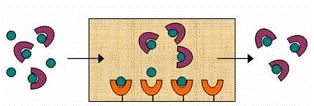Department of Chemistry
Document Type
Article
Date of this Version
3-2009
Citation
Published in final edited form as: J Sep Sci.2009 March ; 32(5-6): 835–853. doi:10.1002/jssc.200800640. Version presented here is from NIH PubMed Central.
Abstract
The binding of drugs with proteins in blood, serum or plasma is an important process in determining the activity, distribution, rate of excretion, and toxicity of drugs in the body. Highperformance affinity chromatography (HPAC) has received a great deal of interest as a means for studying these interactions. This review examines the various techniques that have been used in HPAC to examine drug-protein binding and discusses the types of information that can be obtained through this approach. A comparison of these techniques with traditional methods for binding studies (e.g., equilibrium dialysis and ultrafiltration) will also be presented. The use of HPAC with specific serum proteins and binding agents will then be discussed, including human serum albumin and α1-acid glycoprotein. Several examples from the literature are provided to illustrate the applications of such research. Recent developments in this field are also described, such as the use of improved immobilization techniques, new data analysis methods, techniques for working for directly with complex biological samples, and work with immobilized lipoproteins. The relative advantages and limitations of the methods that are described will be considered and the possible use of these techniques in the high-throughput screening or characterization of drug-protein binding will be discussed.



Comments
Copyright Elsevier Inc. Used by permission.